Great teams implement the right strategy, with the right people in the right way. This is more likely to produce the right results.
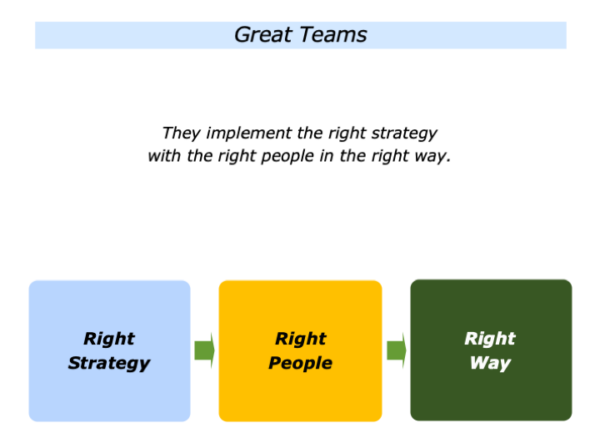
Great teams aim to implement the right strategy with the right people in the right way. Imagine you are leading the team you work in at the moment. Let’s explore how you can pursue these themes in your own way.
The Right Strategy
Such teams start by clarifying their strategy. They aim to climb the right mountain in the right way. They sometimes start by taking the following steps.
They clarify their strengths;
They clarify their perfect customers and the challenges such people they face;
They clarify how they can use their strengths to help their customers to achieve success.
Great teams clarify the possible strategies – the routes forward – they can pursue in the future. They clarify the pluses and minuses of each route together with the attractiveness of each option. After a period of reflection, they settle on their chosen strategy.
Good leaders communicate this strategy to their people. Why? The employees must be able to explain to new joiners why the team has chosen to pursue a specific strategy.
Such leaders also communicate the game plan. They explain the What, Why and How by covering the following points.
The What. The specific goals
we are aiming to achieve are:
*
*
*
The Why. The specific benefits
of achieving the goals will be:
*
*
*
The How. The key strategies we
will follow to achieve the goals are:
*
*
*
Looking at the team you work in at the moment, to what extent do you believe it has the right strategy? Rate this on a scale 0 – 10. What are the specific things it can do to maintain or improve this score?
The Right People
Great teams employ people who have the right attitude and ability. They then put these people in the right places where they are most likely to deliver the right results. There are many models for getting the right people. Let’s explore one approach.
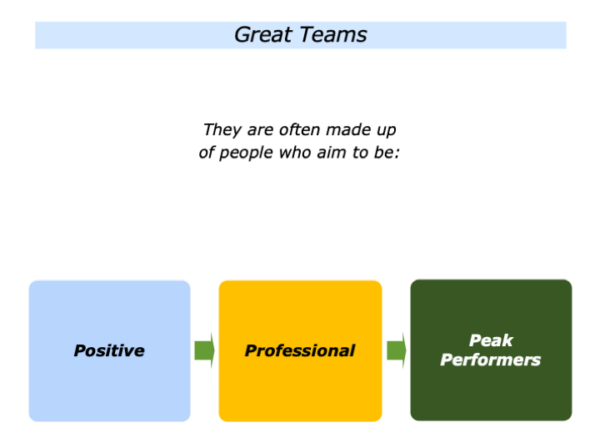
Imagine that you lead your present team. What are the qualities you want your people to demonstrate
One approach is to employ people who aim to be positive, professional and peak performers. Let’s explore how you can identify whether the people in your team demonstrate these qualities.
Positive
Start by looking at each person in your team or those you want to hire. Ask yourself the following questions.
Do they have a positive attitude? Do they generate positive energy? Do they encourage other people? How do people feel after meeting them?
Do they take responsibility? Do they use volunteer language, saying that they want to make things happen? Or do they use victim language, saying that things happen to them?
Do they look for positive solutions to challenges? When appropriate, do they try to find win-win solutions to conflicts? Are they resilient? Do they rebound from setbacks?
On a scale 0 – 10, to what extent would I rate the person as being positive: a) towards customers; b) towards colleagues?
Some employees can behave superbly with customers, for example, but may be difficult with colleagues. Great team members recognise that it is important to be positive with both groups.
Looking at each person in turn, rate them in both areas. Then describe what they can do to maintain or improve the ratings.
Professional
Being positive is a good start, but it is also important for the team members to be competent. They need to support other people and deliver high professional standards.
Bearing this in mind, look at each person in turn and ask the following questions.
Do they behave professionally? Are they customer focused? Do they deliver good service to their external and internal customers? Do they produce good quality work?
Are they self-managing? Are they proactive? Do they make clear contracts with people? Do they meet their promises? Do they want to improve?
Are they good are decision making? When making a decision, do they clarify the real results to achieve? Do they explore the possible options? Do they see the consequences of each option? Do they then make good decisions?
Are they good at proactively managing their key stakeholders? What are the words that their key stakeholders – their managers, customers and colleagues – would say about them?
On a scale 0 – 10, to what extent would I rate the person as being professional: a) towards customers: b) towards colleagues?
Rate them in both areas and then describe what they can do to maintain or improve the ratings.
Peak Performing
What we are looking at is the extent to which a person consistently delivers 8+/10. They may do this by always being professional and then sometimes adding that touch of class.
Great teams are made up of people who continually do superb work and then rise to the occasion when it matters. They may do this when providing great service, managing crises or doing exceptional work.
Bearing these things in mind, ask yourself the following questions about a person.
Do they consistently deliver 8+/10? When do they do work that is effective, excellent and sometimes exceptional? When do that go that extra mile and add that touch of class?
What are their strengths? What are the specific activities in which they deliver As rather than Bs or Cs? How can they use these to make their best contribution to the team?
If this was my own business – and my own money – would I employ this person? If so, what would I hire them to deliver? What would be the benefits to the team?
On a scale 0 – 10, to what extent do I rate the person regarding them delivering peak performances: a) when working with customers: b) when working with colleagues?
Rate the person in both areas and then describe what they can do to maintain or improve the ratings. :
Imagine that you have done these ratings. What are the kinds of scores are you looking for? It can be useful to have people who score the following in each area.
Being Positive: 8+. This is vital because the way they behave will affect other people.
Being Professional: 7+. This is providing they are willing to keep developing.
Being A Peak Performer: 7+. This is providing they are willing to use their talents to the benefit of the team.
One leader explained how he had used this approach when focusing on some of his team.
“The part I found most useful was rating one of my key players in relation to both customers and colleagues.
“He was superb with clients, but terrible with team members. He dismissed people’s opinions and moaned aloud in the office.
“So I gave him the option of: a) choosing to be professional towards team members, or; b) carrying on being unprofessional and, as a result, being moved on from the team.
“After a period of reflection, he chose to be professional towards his colleagues. Since then he has been true to his word, but I am not taking any chances.
“So I have visited his customers, introduced them to other team members and have a back-up plan in case he reverts to his old behaviour.”
It can be good to have team members who aim to be positive, professional and peak performers. This provides the basis for continuing to build a superb team.
The Rebuilding
The Team Approach
“But it is so difficult to get the right people,” somebody may say. Maybe, but it is even more difficult working with the wrong people in the wrong places.
There is a much quoted principle regarding government: “Personnel is policy.” The personal beliefs and qualities of the key people will have a profound influence in the way the policies are implemented.
Imagine that you have a blank piece of paper to rebuild your present team. Imagine also that everybody in the team has left and reapplied to join. Let’s explore how you can revitalise your team.
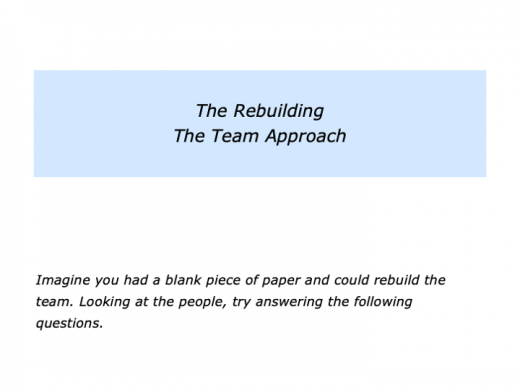
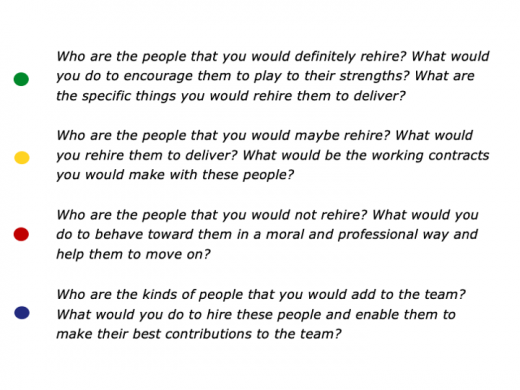
You need people who have a positive attitude and who aim to do professional work. Otherwise you may spend time dealing with people issues rather than working towards achieving the picture of success.
Clarify the people that
you would definitely rehire
Who are the people that you would definitely rehire? Bearing in mind their strengths, what would you rehire each of these people to deliver? How would you make clear contracts with them about their contributions to the team?
You will have your own criteria for making these decisions. Here are the headlines of a response that one leader gave to these questions.
“I know exactly the people that I would rehire. There are several people that form the backbone of the team.
“Mary, the Operations Director, who makes thing work. Sarah, the Sales Director, who is brilliant with certain kinds of clients. Dave, the Human Resources Director, who focuses on how people can use their strengths to implement the strategy.
“Looking at the next level, there are at least five people I would rehire immediately, two of whom could step into the leadership team.
“There are also fine people on Reception and in charge of Facilities. Looking overall, I would rehire about 60% of our people. They provide the backbone for the company.”
Imagine you lead your team. Who are the people you would definitely rehire? How would you encourage them to play to their strengths?
The next step would be to make clear contracts with them about their best contribution. You could agree with them on:
The specific results they will deliver that will contribute towards achieving the team’s goals.
The specific support they need to achieve the agreed goals.
The specific things they will do to proactively keep you informed about their progress towards achieving the goals.
Clarify the people that
you would maybe rehire
Who are the people you would maybe rehire? Bearing in mind their strengths, what would you maybe rehire them to deliver?
What is the attitude you would like them to demonstrate? What are the professional standards – the Dos and Don’ts – you would like them to bear in mind when contributing to the team? How can you give them these messages in a positive but clear way?
How can you then give them chance to reflect and decide if they want to follow these professional guidelines? If they want to opt in, how can you then make clear contracts with them about their best contribution to the team?
You will have your own criteria for making these decisions. Here is the response that the leader mentioned earlier gave to these questions.
“There are one or two people I might rehire, but a lot would depend on their attitude. The leaders of our IT department, for example, must become more customer-focused.
“During the early days we just had a couple of people who took care of the internal systems. At the time they were contractors and really put in the hours. As the business grew, we offered them the chance to lead the department on a full-time basis, which they grabbed straight away.
“Since then the IT department has grown, but the leaders have become locked into their systems, rather than serving the internal customers.
“I might rehire the two original people, because they are talented. But I would invite them to decide if they want to show the commitment they did when working as suppliers.
“For example, I want them to deliver a service where our people say things like:
‘The IT department provides great service that helps us to do our jobs … They are responsive and sort out problems quickly … They help us to get up to speed quickly with the newest technology … They are the best IT department I have worked with in any company.’
“I will give them the chance to decide if they want to get these kinds of responses from our people. If so, I will invite them to produce a plan to ensure they achieve these goals. I will give them a deadline by which this plan should be produced, but I won’t chase them.
“If they do not get back to me by the agreed date – or if they produce a plan but fail to deliver the goods – then that is their choice. I will find people who are prepared to deliver the required professional standards.”
Imagine that you have clarified how you would maybe rehire. The next step would be to make clear contracts with them about their best contribution. You could agree with them on:
The specific results they will deliver that will contribute towards achieving the team’s goals.
The specific professional standards required to make their best contribution to the team.
The specific support they need to achieve the agreed goals.
The specific things they will do to proactively keep you informed about their progress towards achieving the goals.
Clarify the people that
you would not rehire
Who are the people you would not rehire? What are the reasons why you would not rehire these people? How could you manage these situations in a moral and professional way?
Different leaders give different reasons for not rehiring certain people. Here are some that they offer.
“They have the wrong attitude. They have crafted a role that suits them, but it does not add value to the company.
“They rose quickly in the company and got a great financial package. Now the company has changed and we need different things from a person at their level. But they want to carry on doing the same things and drawing a high salary.
“They are high-maintenance. They expect the company to satisfy all their needs rather than them taking responsibility for making their best contribution to the company.”
Imagine you have clarified the people you would not rehire. The next step is to handle the situation in a professional way.
Different people do this in different ways. One approach is to make sure all the legal areas are covered and also to be generous in any package you offer a person.
If appropriate, you may then write a script you want to follow when talking with the person. This may include the following messages.
“As you know, the team faces many challenges as it moves forward. This means that people will need to demonstrate certain qualities to be the right fit with what is required.
“The characteristics that people will need to demonstrate in the future in order to help the team achieve success are:
*
*
*
“Whilst you have certain qualities, unfortunately the ones you have do not fit with what is needed in the future team. We will, of course, offer you the best available package to move on.
“I am prepared to answer any questions you have about this decision. Also, we will provide as much support as we can in helping to make the transition easier for you and the team.
“If you want to reflect for a while, please do so. I will then answer any questions you have regarding the next steps for moving forwards.”
Imagine that you have given a person these kinds of messages. If the person asks for more information about the decision, it is important to be able to give specific reasons.
You can, for example, describe the positive qualities the person would need to have demonstrated. So you may say something like:
“The professional attitude and standards that people need to demonstrate in the future team are:
*
*
“You have certain qualities, but unfortunately have not shown the ones we require in the future. Therefore it is probably not the right fit for you or for the team.”
Clarify the people that you
may want to add to the team
If you wish, clarify the kinds of people you may want to add to the team. One approach is to start by asking yourself the following questions.
What are the individual and collective strengths we have in the team? What are the strengths that we need to add? How can we do our best to hire people who will add those strengths?
Imagine, for example, that you have many people who are entrepreneurial or experts. They have lots of ideas, but sometimes their efforts are not aligned. You may need to add several good co-ordinators. They will make sure that people align their efforts and get the work done.
Good leaders are like good sports coaches. They spend a lot of time looking for potential hires. Aiming to get ahead of the game – rather than being left in the lurch – they fill the recruitment pipeline with people who might want to work in their team.
The General Manager of one hotel chain I worked with, for example, took notice of people who gave him good service on his travels. If appropriate, he would hand them his card and say something like the following.
“You gave us great service today. If you are ever interested in developing your career, let me know. Drop me an email and we can have an informal chat over coffee.”
Clarify the specific things that
you can do to rebuild the team
How can you translate these ideas into action? One person explained this approach in the following way.
“I do this exercise every year and act on it. At first it seemed a bit scary, but that was because there was so much to sort out.
“It took six months to get the team right, but now it functions brilliantly. Nevertheless, I still do the exercise to ensure we stay on track.”
Imagine that you have done the previous exercises. Bearing in mind the decisions you have made about people you may want to take the following steps.
You can rehearse the conversations
you are going to have with each person
This is vital. Make sure you are crystal clear on the key messages you want to give to: a) the people you definitely would rehire; b) the people you maybe would rehire; c) the people you would not rehire; d) the people you want to add to the team.
You can rehearse how to make clear contracts
with the people who will be in the future team
This will involve agreeing on the results they will deliver and the support needed to achieve the goals. Looking ahead at the different types of conversations, anticipate the potential challenges. Rehearse how you can deal with these in a professional way.
Let return the theme of having the right people in the team. Imagine that you lead your present team. Do you have the right people in the right places in the team? What can you do to make this happen?
The Right Way
Great teams encourage, educate and enable people to implement the right strategy in the right way. People can then keep delivering high professional standards on the way towards achieving the right results.
Imagine you lead your present team. Let’s assume you have communicated the purpose, principles and picture of success. Everybody has also made clear contracts about their best contributions. You can then aim:
To make sure that every team member has the support required to do the job;
To hold monthly update sessions where each person presents the following:
a) the things they have done in the last month towards achieving the goals;
b) the things they plan to do in the next month towards achieving the goals;
c) the challenges they face, their strategies for tackling these challenges and the support they need to reach the goals.
Imagine that you continue to take these steps. It will also be important to maintain the momentum.
One approach is to keep publishing success stories that highlight when people have performed superb work and how the team can follow these principles in the future.
If appropriate, you also encourage people to embody the concept of continuous improvement and do what is necessary to ensure the team delivers success.
This piece has explored ways to implement the right strategy with the right people in the right way. If you wish, try tackling the final exercise on this theme. This invites you to complete the following sentences.
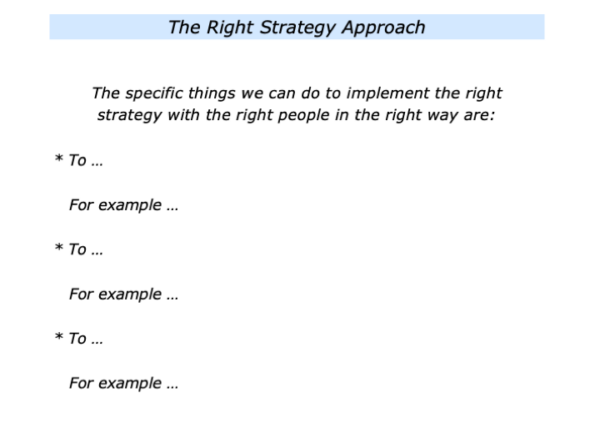






Leave a Reply